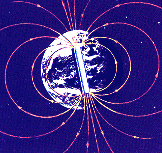
(Section 5.12)
The subjects of magnetism and electricity developed almost independently of each other until 1820, when a Danish physicist named Hans Christian Oersted discovered in a classroom demonstration that an electric current affects a magnetic compass. He saw that magnetism was related to electricity. We will begin by looking at permanent magnets and then look at Oersted’s experiment.

Magnets have a north and a south pole. Like magnetic poles repel each other and unlike poles attract each other. The names of the poles come from the fact that the earth has a magnetic field. The part of the magnet that will align toward the north pole of earth is called the north pole of the magnet.
Some atoms, depending on their electronic structure, act like magnets and
have a north and south pole. In
most matter, there is no alignment of the poles of the atoms. In a bar magnet,
the atoms will line up. Sometimes
this alignment can be achieved by simply banging on a piece of iron.
This can cause some of the atoms to line up with the earth’s magnetic
field.

The iron atoms in an unmagnetized iron bar are
randomly oriented, whereas in a magnetized bar they are aligned with their north
poles pointing in the same direction. The ability of iron atoms to remain
aligned in this way is responsible for the magnetic properties of iron.